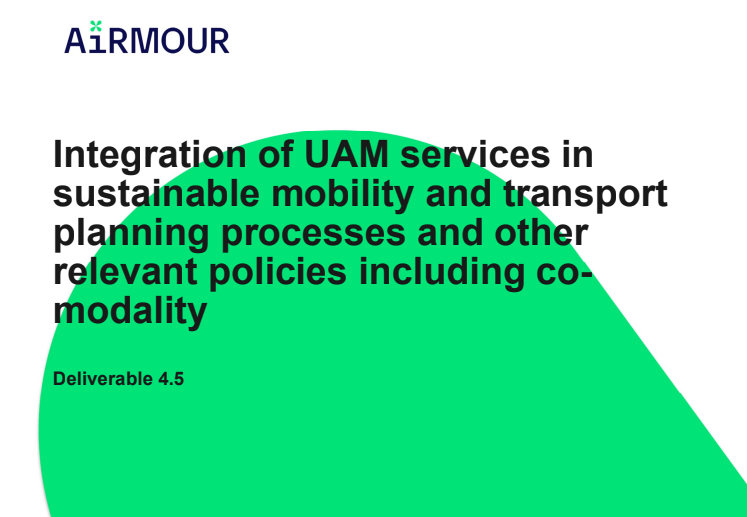The AiRMOUR research project has released a report on the integration of UAM services in sustainable mobility and transport planning processes and other relevant policies including co-modality (deliverable 4.5). This report provides an understanding of how Urban Air Mobility (UAM) can be integrated into the existing urban context as well as their evolving policies.
Around 70% of Europe’s population lives in urban areas (European Court of Auditors, April 2019), traditional traffic infrastructure faces increasing challenges, particularly during peak hours and along routes to and from urban areas. The introduction of Urban Air Mobility (UAM) marks a shift into the third dimension—the airspace. AiRMOUR, a research and innovation project, focuses on exploring sustainable air mobility for emergency and medical services in urban contexts. The initial deployment of emergency and medical services using UAM has the potential to extend its benefits to other UAM service models over time. This deliverable aims to examine the insights gained from the AiRMOUR project and assess their implications for urban stakeholders and relevant policies. The project seeks to understand how the lessons learned can contribute to a more broader advancement of UAM in urban environments.
Urban Air Mobility (UAM) is a concept that has the potential to revolutionize air travel, the way we move within cities, as well as transport goods. UAM has gained significant attention in recent years as a potential solution for addressing congestion and mobility challenges in metropolitan areas. (Anna Straubinger, August, 2020). UAM and or aerial vehicle concepts for passenger transportation promise a safer, more reliable, and more environmental alternative to alleviate congestion on transport networks (AirBus, 2017).
The earlier introduction of sustainable urban modes, such as cycling, carsharing, and bus rapid transport, along with the re-introduction of rail-based urban transportation like trams and light rail, has revealed that congestion is a more intricate issue. It is not solely addressed by the introduction of new means of mobility. While Urban Air Mobility (UAM) is not poised to replace most existing mobility and transportation services, the anticipation is that as the first commercial Beyond Visual Line of Sight (BVLOS) flights for goods become operational and initial demonstrations of people transportation with electric Vertical Take-off and Landing (eVTOL) aircraft are showcased, UAM will become a part of the modal choice. Eventually, it is expected to contribute to co-modality and become a component of multimodal transportation.
The introduction of U-space, a traffic management system for lower airspace, coupled with the evolution of Unmanned Aircraft Systems (UAS) also known as remotely piloted aircraft systems (RPAS) or drones, is anticipated to enhance the capacity of urban mobility and transport infrastructure.
For UAM to be a success, it will have to integrate into the wider city infrastructure. An integration that allows the provision of service levels both for personal transportation and for urban logistics. It should also offer quality and time savings over existing modes at a price point that individuals are willing to pay. For that policies and regulations have to evolve and service to be set up in ways that are acceptable to local communities. In addition, for any public authority to allow for such services, it will need to be assured that there is a real social value of UAM and a contribution to the wider socio-economic impacts.
Considering the AiRMOUR Emergency and Medical Service (EMS) use cases for which usage of UAM was validated, this deliverable tries to establish a link to present U-space and UAM regulations, strategies and future urban policies. Secondly an analysis of different urban planning practices (e.g., sustainable urban mobility plans, urban development planning) will take place. Following will also be looked at other urban social, noise and environmental policies at the urban level to allow for EMS UAM services. Therewith a multidimensional map of stakeholder interests and citizen engagement strategies that allow for public acceptance.
Based on the quantitative data collected on public acceptance, perceptions of risks, safety, noise, visual pollution and privacy, as well as the gathered qualitative feedback from the workshops organized in the frame of the AIRMOUR live validations in Helsinki, Kassel, Stavanger and Luxembourg it is possible to provide an insight on the impacts for each of relevant urban policy domains.
Read the report here
For more information visit:




